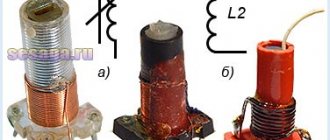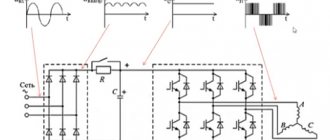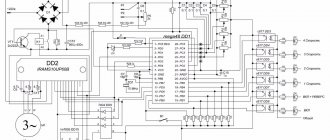An electric convector is a heating device that heats a room through convection. Unlike the same fan heaters, where warm air is forcibly blown out and distributed throughout the room, an electric convector uses the natural movement of air flows that occurs due to temperature differences. Thanks to this, the device operates silently.
The convector device is not complicated. The device consists of the following parts:
- frame;
- radiator screen;
- a heating element;
- temperature sensor;
- thermostat;
- on-off block.
Main varieties
Various energy sources can be used to operate convection heating in a private home, but most household devices of this type are equipped with electric heaters. There are also gas convectors that run on gas. The great popularity of electric models for heating rooms is explained by their compact dimensions. In cases where convective heating plays the role of the main one (which often happens in country houses and dachas), it is more profitable to use gas modifications, because gas is much cheaper.
Based on the installation method, convectors are:
- Floor-standing
. Designed for floor placement. Some models are equipped with special wheels for mobility. In other cases, a rigid installation is used, without the possibility of movement. - Wall mounted
. They are hung on the walls of the room, for which the product kit includes the appropriate fasteners. - Built into the floor or baseboard. This installation principle allows you to save living space.
Tips for use
Proper operation will extend the life of the convector and make its operation as safe as possible. In general, convection equipment does not require special conditions, but basic rules should still be followed.
- Periodically, dust must be removed from the body of the device when it is turned off.
- When installing, make sure that the lower part of the convector rises above the floor by at least 15 cm, and is 25 cm from the wall.
- Do not cover the convector with any objects on top, hang laundry or place it in a niche that is too low. There should be a distance of about half a meter at the top, otherwise the convector will overheat. This will lead to damage (unless the device is equipped with a special overheating sensor).
- If there are children in the house, try to choose a stationary type convector model without wheels.
The following video provides a detailed overview of trench convectors.
Frame
Most often, steel is used for the manufacture of modern convectors. The design of the housing can be very diverse, so there are usually no problems with choosing a heater for a specific style of room. There are special fastenings (brackets) on the body of wall-mounted modifications: they make it possible to remove the device from time to time for maintenance.
In some cases, the protective steel box of the convector is equipped with adjustable blinds on the sides: by changing their angle, you can adjust the direction of air flow. This design solution allows for volumetric distribution of heat in the room, which makes its heating more uniform. To avoid underheating, when choosing a convector, it is recommended to leave some power reserve (especially if it is installed in a corner room).
Principle of operation
The operation of this heater is based on the ability of air to rise upward when heated.
In a convector, this property is implemented as follows: cold air located at the bottom of the room enters the convector through the lower grille.
Passing through the heating element with a diffuser, the air heats up and rises upward, where it exits through the upper grille.
Hot air rushes upward and displaces cooler air, which falls down and enters the convector.
In this way, air is circulated through the convector, which ensures constant heating of the air, and as a result, the temperature in the room.
Additionally, heat exchange is carried out by the convector body itself. The air, rising up inside the housing, heats it, and it subsequently gives off heat to the external environment.
This design is good because even with maximum heating, the walls of the case do not heat up too much, which ensures safety.
The temperature to which the air should be heated when passing through the convector heater is set on the control unit.
A heating element
Electric convectors are equipped with various heating elements. The most inexpensive solution is steel products, found in the cheapest appliances. The high temperature of the heating coil (up to +160 degrees) allows the room to quickly warm up. However, spirals of this type have a low degree of safety: phenomena such as the accumulation of dust or accidentally ingress of water can cause the device to catch fire. The popularity of spiral convectors is explained, first of all, by their low cost. Some manufacturers additionally equip the device housing with special fans, which, in combination with a high-temperature coil, increases the heating intensity.
More expensive models are equipped with safe low-temperature coils that heat up only to +100 degrees. Elements of this type have the form of dissipative radiators made of aluminum with a built-in steel pipe. A special heating filament is located inside this tube. Thanks to the aluminum housing, heating efficiency is noticeably increased. In some models, instead of one, two tubes are used, which allows you to adjust the operation of the heating block.
The different degrees of expansion exhibited by aluminum and steel provoke a gradual decrease in the reliability of the connection between the heating tube and the housing. As a result, this can lead to a complete breakdown of the connection between them. As a result, there is a danger of local overheating of the tube and damage to the heating element. Manufacturers of convection equipment are constantly searching for a solution to this problem.
RX-Silence heating devices, developed and patented by NOIROT (France), are particularly unique. The innovative design of these convector boilers lies in the complete tightness of the silumin body, where magnesium powder is used to seal the nichrome heating filament. The expansion coefficient of the materials used has very similar values, which makes it possible to significantly reduce energy consumption and increase the service life of the convector to 15-17 years.
Convector heating control unit
The simplest version of the control unit for convection heating is a thermostat installed inside the heater body. Thermostats are divided into electromechanical and electronic. Electromechanical devices are cheaper, which affects their operating accuracy (the error sometimes reaches 2C0). It is also worth highlighting the noise that occurs from the clicks of the bimetallic sensor when the device is turned on. To set the required temperature regime, electromechanical models have a knob marked with the conditional values of the convector power.
Electronic thermostats are more accurate: their error rarely exceeds 0.1 C0. In addition, convectors of this type are completely silent. A number of models make it possible to program the electronic control unit to enable various operating modes and power, depending on the time of day and day of the week. At the same time, electronic thermostats have the function of remote control of the heating element using an external control device.
As a result, it becomes possible to monitor the operation of a significant number of heaters located in different parts of the home. The convector heating system unit allows the use of built-in operating mode programs separately for each room, or for the entire house in the complex. The French manufacturer NOIROT and the German corporation Siemens are leaders in the market of “intelligent” convectors. Their products provide the ability to control the temperature remotely via phone. This allows you to warm up your home well before your arrival.
How does it work
Note! The operating principle of the described device is based on the phenomenon of convection. From the physics course we know that cold air is heavier than warm air, it is located in the lower part of the room, heated air masses gradually rise upward
Due to such movements, the entire air space in the room is heated.
The convector operates according to a simple algorithm. At the bottom of this device there is a heating element (it is also called a heat exchanger). To increase the volume of air passed through, this part is made in the form of a radiator with several flat fins. The angle of their inclination regulates the direction of heated air flows. The heat exchanger is covered by a protective metal casing.
According to the energy carrier used, all convectors can be divided into the following types:
- Devices powered by electricity;
- Gas convectors;
- Mermen.
Convector heater device
At the top, as well as at the bottom of the convector body, there are several holes for sucking in cold air and transporting heated air. Structurally, it is made in such a way that the body of our device does not have direct contact with the heat sink, so the casing does not heat up and does not transfer heat. A similar transfer of heat resources occurs in water and oil radiators.
In everyday life, electric type convectors are mainly used. Water appliances have lower efficiency indicators; they differ from analogues in their significant overall dimensions, so they are installed in places where traditional water radiators are installed in niches under windows. Gas equipment, despite the possibility of saving energy resources, for some reason is not popular among consumers.
All models of the heaters under consideration, regardless of type, may have different overall dimensions. Some of them are equipped with built-in sensors and many additional functions. The main advantages of convectors are:
- Quiet operation. This characteristic is due to the absence of a fan in the device that hums;
- Possibility of installing the device on various surfaces (on the floor or wall, there are models that can even be installed on a windowsill);
- Beautiful design that will allow the installation to “fit” into any interior;
- Low heating temperature of the case, on average 60 degrees, maximum parameters - 90 degrees;
- Large models have wheels for easy movement around the room; lightweight devices can be mounted on the wall;
- When heating a room with a convector, oxygen is not burned;
- Devices can be left unattended;
- Long-term operation. Many manufacturers provide a 10-year warranty on the product.
Operating principle of the convector
Despite the huge number of advantages, convectors also have negative qualities. The disadvantages of such devices include:
- Low noise level when warming up;
- Impossibility of replacing the heating element at home;
- The absence of a fan affects the rate at which the room warms up.
Note! The movement of well-heated dry air in a room affects the well-being of allergy and asthma sufferers. The ideal option for such people would be a convection air conditioner equipped with a humidifier.
Main settings
Having figured out what convector heating is, you should arm yourself with general information about its technical characteristics. The power of electric convectors is in the range of 0.8 -3 kW, weight - from 3 to 9 kilograms.
Electric convectors currently available for sale are divided into three groups:
- High (450-670 mm).
- Medium (up to 330 mm).
- Narrow (for skirting boards), 140-200 mm high.
Due to their parameters, high-type heaters are able to provide a significant level of convection. Skirting models are equipped with less powerful heating elements. To maintain the proper level of efficiency, they are given a large length (up to 2.5 m).
heating elements
Next you should pay attention to the heating elements. Needle-type heating elements, where the spiral is not protected by anything and is fixed on a thin plate, are very fragile; a small blow to the body is enough for the spiral thread to break.
But such convectors are much cheaper than with other types of heaters.
The most reliable and durable are monolithic heating elements. They are not afraid of shocks and can even withstand the device being tipped over. However, the cost of devices with heating elements is much higher.
The choice of monolithic heating elements is also supported by the operation of the convector itself.
Needle-type heaters may crackle slightly during operation, while monolithic heaters are absolutely silent.
Gas convectors
Along with electric convectors, gas-powered appliances with a very similar operating principle are also produced. In this case, gas burners are used instead of spirals to operate the devices. They look like special chambers, the walls of which, as they heat up, transfer heat to the battery. Heating of the surrounding space is carried out directly by the radiator.
Pros and cons of gas convector heating:
- Gas devices do not use complex electronic controls.
- The cost of gas is an order of magnitude cheaper than electricity, so it takes less money to heat your home.
- The complexity of their installation and increased operational requirements (for example, the presence of a chimney) limits the scope of use of gas convectors exclusively to the private sector.
Additional functionality
Many convector heaters are equipped with additional functions that can be very useful.
One of these functions is the additional equipment of the device with an ionizer.
In addition to heating, such a device will also purify the air, preventing the spread of pathogenic microbes.
An interesting thing is that the ionizer can work even when the convector does not perform its main function - heating.
But a device equipped with an ionizer can accumulate static electricity, so it requires grounding.
Another useful function is the so-called anti-freeze of the device. This function boils down to the fact that when the temperature in the room drops to a critically low level, for example, to +5 C, the device itself will turn on to increase the temperature in the room.
A very convenient function if you plan to be away from home for a long time.
In programmable convectors, a memory function for temperature settings can often be observed.
This function allows you to save all temperature settings and the device will start working with the specified parameters even after temporarily de-energizing it.
And this is only part of the additional functions that a convector heater can be equipped with.











